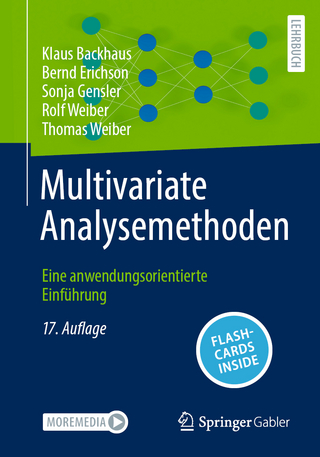
An Introduction to IMS
IBM Press (Verlag)
978-0-13-185671-4 (ISBN)
- Titel erscheint in neuer Auflage
- Artikel merken
The Only Up-to-the-Minute Guide to IMS Version 9--Straight from IBM IMS Experts
Introduces IMS, one of the world's premiere software products
Thoroughly covers key IMS functions, from security to Java support
For both new and experienced IMS administrators, programmers, architects, and managers
Prerequisite reading for IBM IMS Mastery Certificate Program
IMS serves more than 95 percent of Fortune 1000 companies, manages 15,000,000 gigabytes of production data, and supports more than two hundred million users per day. The brand-new IBM IMS Version 9 is not just the world's #1 platform for very large online transaction processing: it integrates with Web application server technology to enable tomorrow's most powerful Web-based applications. Now, for the first time in many years, there's a completely up-to-date guide to understanding IMS in your business environment.
An Introduction to IMS covers
Installing and configuring IMS Version 9
Understanding and implementing the IMS hierarchical database model
Understanding and working with the IMS Transaction Manager
Mastering core application programming concepts, including program structure and IMS control blocks
Taking advantage of IMS 9 Java programming enhancements
Working with the IMS Master Terminal
Administering IMS: system definition, customization, logging, security, operations, and more
Running IMS in a Parallel Sysplex(r) environment
Whether you've spent a career running IMS or you are encountering IMS for the first time, this book delivers the insights and skills you need to succeed--as an application designer, developer, or administrator.
Dean H. Meltz, team lead for IMS Information Development at IBM's Silicon Valley Lab, in San Jose, California, has been an IMS technical writer for seventeen years. Rick Long, IMS systems specialist with IBM's International Technical Support Organization (ITSO), writes about IMS and teaches IMS classes worldwide. He was previously an IMS systems programmer for IBM Global Services, Australia. Mark Harrington, IMS systems programmer at IBM Global Services, UK, has spent twenty-two years working with IBM mainframes as developer, application designer, installer, and DBA. Robert Hain has been an IMS systems programmer for seventeen years. He works for IBM Global Services, Melbourne, Australia, as part of the Telstra Alliance. Geoff Nicholls, a member of IBM's Worldwide IMS Technical Support Team, works with IMS customers throughout Australia and Asia.
Figures xiiiTables xviiForeword xixPreface xxiiiAcknowledgments xxvAbout the Authors xxviiPart I Overview of IMS 1Chapter 1 IMS: Then and Now 3History of IMS: Beginnings at NASA 3
Is IMS Still Strategic for Customers and IBM? 4
Chapter 2 Overview of the IMS Product 9IMS Database Manager 10
IMS Transaction Manager 12
IMS System Services 13
IMS Documentation 13
Hardware and Software Requirements for IMS 13
Chapter 3 Accessing IMS 17Accessing IMS from Application Programs 17
Accessing IMS from Other Products 22
Chapter 4 IMS and z/OS 27How IMS Relates to z/OS 27
Structure of IMS Subsystems 28
Running an IMS System 43
Running Multiple IMS Systems 44
How IMS Uses z/OS Services 45
Chapter 5 Setting Up and Running IMS 49Installing IMS 49
Defining an IMS System 51
IMS Startup 51
IMS Logging 54
IMS Utility Programs 54
IMS Recovery 55
IMS Shutdown 56
Part II IMS Database Manager 59Chapter 6 Overview of the IMS Database Manager 61Functions of the IMS Database Manager 61
Implementation of IMS Databases 62
Storing Data in IMS and DB2 UDB for z/OS 64
Storing XML Data in IMS 65
Chapter 7 Overview of the IMS Hierarchical Database Model 67IMS Hierarchical Database Basics 68
Basic Segment Types 72
Sequence Fields and Access Paths 73
Chapter 8 Implementing the IMS Hierarchical Database Model 83Segments, Records, and Pointers 84
IMS Hierarchical Access Methods 87
Operating System Access Methods 109
IMS Checkpoints 111
Locking Data 114
Chapter 9 Data Sharing 119How Applications Share Data 120
DBRC and Data Sharing 121
Chapter 10 The Database Reorganization Process 123Purpose of Database Reorganization 124
When to Reorganize Databases 124
Overview of the Database Reorganization Process 128
Chapter 11 The Database Recovery Process 151Determining When Recovery Is Needed 151
Overview of the Database Recovery Process 152
IMS Backup and Recovery Utilities 153
Part III IMS Transaction Manager 167Chapter 12 Overview of the IMS Transaction Manager 169IMS TM Control Region 170
IMS TM Messages 171
IMS Transaction Flow 173
IMS TM Network Overview 175
The Data Communication Control (DCCTL) Environment 189
Operating an IMS Network 190
Chapter 13 How IMS TM Processes Input 195Input Message Types 195
Terminal Types 197
Input Message Origin 197
Terminal Input Destination 197
Message Queuing 198
Message Scheduling 206
Transaction Scheduling 208
Part IV IMS Application Development 215Chapter 14 Application Programming Overview 217Java Programs 218
Application Program Structure 218
IMS Setup for Applications 230
IMS Application Programming Interfaces 235
IMS Application Calls 235
Accessing DB2 for z/OS Using a Resource Translation Table 237
IMS System Service Calls 237
Testing IMS Applications 239
Chapter 15 Application Programming for the IMS Database Manager 241Introduction to Database Processing 241
Processing a Single Database Record 246
COBOL and PL/I Programming Considerations 261
Processing Databases with Logical Relationships 265
Processing Databases with Secondary Indexes 267
Loading Databases 269
Using Batch Checkpoint/Restart 275
Chapter 16 Application Programming for the IMS Transaction Manager 281Application Program Processing 281
Transaction Manager Application Design 289
Chapter 17 Editing and Formatting Messages 297Message Format Service 298
Basic Edit Function 308
Chapter 18 Application Programming in Java 311Describing an IMS Database to the IMS Java Function 312
Supported SQL Keywords 313
Developing JMP Applications 314
Developing JBP Applications 315
Enterprise COBOL Interoperability with JMP and JBP Applications 316
Accessing DB2 UDB for z/OS Databases from JMP or JBP Applications 317
Developing Java Applications That Run Outside of IMS 317
XML Storage in IMS Databases 321
Part V IMS System Administration 327Chapter 19 The IMS System Definition Process 329Overview of the IMS System Definition Process 330
IMS System Definition Macros 335
The Extended Terminal Option (ETO) 338
Chapter 20 Customizing IMS 347What You Can Customize 348
Naming the Routines 349
Changeable Interfaces and Control Blocks 349
IMS Standard User Exit Parameter List 349
Binding the Routines 349
Saving Registers 350
IMS Callable Services 350
Considering Performance 351
Summary of IMS Exit Routines 352
Chapter 21 IMS Security 361History of IMS Security 361
Security Overview 361
Securing Resources 363
Chapter 22 IMS Logging 367IMS System Checkpoints 367
Database Recovery Control Facility (DBRC) 368
IMS Log Components 368
Chapter 23 Database Recovery Control (DBRC) Facility 375Overview of DBRC 376
DBRC Tasks 376
DBRC Components 377
When Should You Use DBRC? 378
Communicating with DBRC 379
DBRC Functions 381
Overview of the RECON Data Sets 395
Defining and Creating the RECON Data Sets 398
Initializing the RECON Data Sets 399
Allocating the RECON Data Sets to an IMS System 400
Maintaining the RECON Data Sets 401
Reorganizing RECON Data Sets 403
Recreating the RECON Data Sets 404
Summary of Recommendations for RECON Data Sets 404
Chapter 24 Operating IMS 405Monitoring the System 405
Processing IMS System Log Information 406
Choosing Tools for Detailed Monitoring 413
Executing Recovery-Related Functions 419
Modifying and Controlling System Resources 421
Controlling Data Sharing 428
Controlling Log Data Set Characteristics 431
Connecting and Disconnecting Subsystems 436
Chapter 25 IMS System Recovery 439Overview of Extended Recovery Facility (XRF) 440
Overview of Remote Site Recovery (RSR) 440
Comparison of XRF and RSR 441
Summary of When to Use XRF or RSR 442
Chapter 26 IBM IMS Tools 443Database Administration Tools 443
Application Management Tools 447
Performance Management Tools 450
Recovery Management Tools 452
Information Integration Management Tools 455
Utilities Management Tools 456
TM Management Tools 461
Miscellaneous IMS Tools 463
Part VI IMS in a Parallel Sysplex Environment 465Chapter 27 Introduction to Parallel Sysplex 467Goals of a Sysplex Environment 468
IMS and the Sysplex Environment 469
Other Advantages of Running IMS TM in a Sysplex Environment 485
Chapter 28 IMSplexes 495Components of an IMSplex 496
Requirements for an IMSplex 498
Operating an IMSplex 499
Part VII Appendixes 501Appendix A Glossary 503Appendix B Acronyms and Abbreviations Used in This Book 511Appendix C Notices 517Appendix D Bibliography 521Index 525
| Erscheint lt. Verlag | 3.3.2005 |
|---|---|
| Verlagsort | Armonk |
| Sprache | englisch |
| Maße | 243 x 185 mm |
| Gewicht | 1043 g |
| Themenwelt | Mathematik / Informatik ► Mathematik ► Finanz- / Wirtschaftsmathematik |
| ISBN-10 | 0-13-185671-5 / 0131856715 |
| ISBN-13 | 978-0-13-185671-4 / 9780131856714 |
| Zustand | Neuware |
| Informationen gemäß Produktsicherheitsverordnung (GPSR) | |
| Haben Sie eine Frage zum Produkt? |
aus dem Bereich



